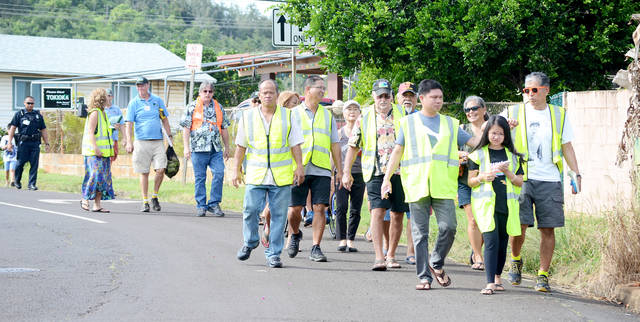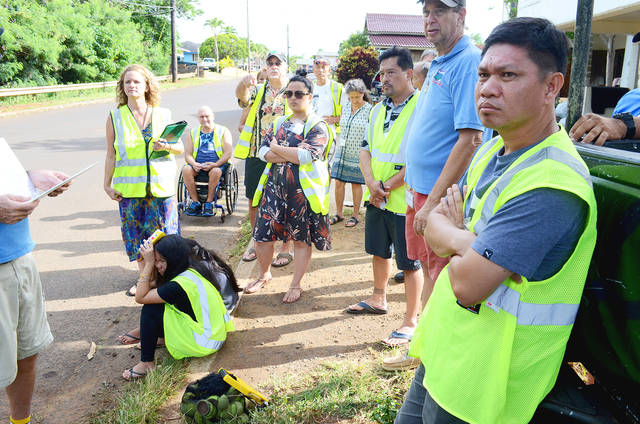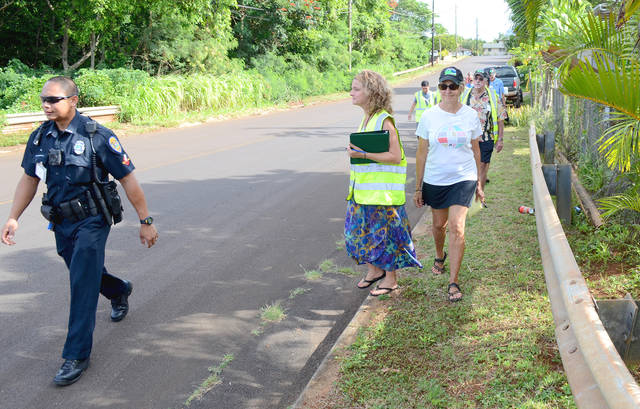“Arayza, will you walk us through your journey that morning?”
The 13-year-old nodded yes.
With her father Raymond Sabay by her side, she put on a bright yellow safety vest, took the point position and began the short walk from the driveway of her Hoohana Street home, heading toward Laukona Street.
About 15 adults, many also wearing safety vests, fell in line behind her. After a few minutes, the walkers slowed to a stop in front of a driveway and stood around Arayza as they surveyed Laukona Street.
Questions came quickly.
Where did the accident happen?
Did she remember being hit?
Were there other children around?
Where is the bus stop?
The young girl with long, dark hair and shy smile carried a notebook and a pencil. She answered as best she could. No other children. The bus stop was down and on the other side of the street. She didn’t remember other specifics of the morning.
The adults, some elected leaders, some seeking public office, and a few others in charge of this gathering, continued to scan the street. Every 20 or 30 seconds or so, a car passed by. Before this review was over, Kauai Police Officer Russell Himongala would remind the group to be respectful of traffic and stay in single file. Earlier in the walk, the group filtered out in a wide path.
“This is good but at the same time, we need to be responsible for our actions,” he said.
“We’re here, and I want to set an example,” said Himongala, one of the investigators in the case.
At another point, he waved and called for the driver of a passing car to slow down on the 25 mph street.
Through it all, Arayza patiently answered more questions. As she continued the walk, she shielded her face from the sun, pointed to the bus stop where she was heading, and later sat on the curb, the adults in a semi-circle around her.
The goal of the tour was to improve safety on this street that has no sidewalks, no stripes, nothing really to indicate where pedestrians would be separated from vehicles.
It was on Laukona Street where Arayza was struck by a vehicle and critically injured on Jan. 11 while walking to the bus stop. Her recovery, slow and painful, was considered by some nothing short of miraculous.
With the help of physical therapy, ohana, determination and prayers, she battled back from a brain injury, fractured jaw, vision problems and an injury to her hand. She is emerging to her old self, a playful girl who likes to be with her family.
But on a warm late afternoon, five and a half months after that hit-and-run incident that nearly claimed her life, Arayza Sabay, her vision still impaired from the accident, bravely led adults she just met that day with a goal of making sure something like that never happens again.
•••
Janice Ferraz was the facilitator of last weekend’s gathering organized by Kauai Path as part of what was described as a “Solutions Meeting.”
They are billed as public forums to review where a person has been severely injured or killed, and to find ways to make streets and roads safer for all users.
“Notice what changes would prevent such incidents in the future and make improvements for safety,” Ferraz told the group.
The conversation would cover engineering, education, encouragement, evaluation and enforcement measures.
“Roadway design should be based on the premise that humans are fallible, and will make mistakes,” read an invitation to the meeting. “If you take a nuclear power station, if you take aviation, if you take a rail system, all of them are based on the idea that they are operated by people who can make a mistake. The same understanding should influence roadway design, where traffic calming, well-marked crosswalks and pedestrian zones, and separated bike lanes can help minimize the consequences of a mistake. In every situation a person might fail. The road system should not.”
A 59-year-old Hanamaulu man, Virgil Caday, was later taken into custody and released on Jan. 20 in connection with the case. He was arrested on suspicion of first-degree negligent injury, accidents involving serious bodily injury, inattention to driving, tampering with physical evidence and tampering with a witness.
Police have forwarded the case to the Prosecuting Attorney’s office.
•••
Laukona is about 40 feet wide, big enough for parking on both sides and two unobstructed travel lanes. There is no parking allowed on this street. It includes a short downhill with a turn not far from the Sabay home.
Arayza had walked about 340 feet from her home when she was hit. It wasn’t clear which side of the road she was walking on at the time. She had to cross the street to reach the bus stop. It was before 7 a.m. and still dark when the accident happened on that downhill stretch.
Himongala could not give many specifics as the case is ongoing.
Pedestrians should always pay attention, Himongala said. Don’t wear headphones, be aware of vehicles, be alert.
“There’s a lot of things we can do,” he said.
Later, back at the Sabay home, the group outlined possible solutions. Those included striping, reflectors, a clearly marked pedestrian path, flexible delineator posts, curbing and sidewalks.
The county would have to approve any changes.
County Council candidate Harold Vidinha said many of the proposals were good, but could take a long time to carry out. He said white stripes could be painted on the road quickly.
“At last you’re giving the kids space to walk now, when they start school again,” he said. “Right now, until this is implemented, they will be going on the road, off the road, all the way down.”
“Until we get something concrete and get it to the county, get it passed, they’ll still be in danger,” Vidinha said. “I suggest an immediate fix.”
Councilmember Mason Chock agreed.
“That white line is so important,” he said.
Council candidate Juno Apalla suggested they watch the natural paths children take in the mornings to reach the bus stop.
Chad Taniguci, Hawaii Bicycling League executive director, said enforcing the speed limit consistently over time would have an effect.
“You do that enough and it changes behaviors,” he said.
Adding stripes would narrow the road, he added, and would slow traffic.
The placement of the bus stop was also criticized.
“I’ll be honest,” said council candidate Roy Saito. “That bus stop is ridiculous.”
Tommy Noyes of Kauai Path, an organizer of the walk, suggested lowering the residential speed limit throughout the island.
“A lot of what we saw today, people were exceeding the 25 mph limits,” he said.
He turned toward Raymond Sabay and asked, “Do people go past your house fast?”
Sabay nodded.
“Sometimes,” he said.
•••
Ferraz liked what she heard.
“They were very thorough and people saw things that could be changed and offered their ideas,” she said.
Ferraz knows about such incidents. The teacher was severely injured in a hit-and-run as she biked home from school on May 4, 2017.
Her pelvis was crushed, she was hospitalized and she couldn’t even walk after the incident. She still hasn’t fully recovered from the injuries, but she was leading the discussion at the Sabay home.
Ferraz said the accident changed her life.
“Where I focus my energy now is different than before,” she said.
There are things she could do before, but not now.
“I’m learning. My awareness is growing,” she said. “If I wouldn’t have been hit I wouldn’t have the awareness I have now, or the compassion.”
Noyes said the walk led by Arayza was part of the process of trying to improve streets for vehicles and pedestrians.
“Now it’s a matter of taking the necessary steps to improve safety in our neighborhoods,” Noyes said.
As the adults returned to their cars and headed home, and shadows fell across the street, it was quiet.
And Arayza Sabay played quietly in the yard.
•••
Bill Buley, editor-in-chief, can be reached at 245-0457 or bbuley@thegardenisland.com.






This a step-by-step on how to further traumatize a child: have them relive the experience with 15 strangers grilling them random questions they have no answers to. Feels good for the adults who dropped the ball protecting the child to begin with – but does no good for the child.
Seriously. It doesn’t take a child to inform you on highway design and safety. Or does it? The lack of safe pedestrian and bike ways on Kauai is a known fact.
Hanalei it is a tragedy waiting to happen. Locals (yes, young men in pick up trucks to and from the pier) and tourists gun down Aku while overgrown plants on county land push families into the street along blind corners. Pretty simple to have the County push back illegal fences and clear their land easement along the road there and Weke. They just don’t do it for whatever reason. Lack of funding. Lack of awareness? Who knows. Someone will die on these roads in the near future because of it.
The pedestrian path to Dolphin from Hanalie is the road. The path to the Saturday Farmers Market is also the road. Thousands of people walk these routes every day. The road north out of town also has zero room for bikes or pedestrians.
There is no mystery why this child got run over. The condition for this to happen again is everywhere on Island. Skip the theater of walking with a traumatized child and call in a traffic engineer from Oahu or the mainland to consult you on street design if you really want to fix the many issues on Kauai.
Knowing at the time she was walking to the bus stop. It was dark. If she was walking against traffic( which is the right way we were thought). She was doing the right thing. What color was her clothing(bright or dark).
For the driver not to see her. He must have been speeding on a dark and unlighted street.
We here on Kauai live in the dark once the sun goes down to 0730 HRS. the next day at that time of the year(December to early March)
It’s lucky that this little girl is still alive. It’s time to partition our County and State to have them fight the Federal Government to light up our streets and highway.
Street safety is about ALL roadway users. Vehicle drivers are at the top of the food chain and are obligated by law to yield to other users when negotiating turns and overtaking.
hitting a person riding a bike is a accident but leaving her in the ditch is a crime.